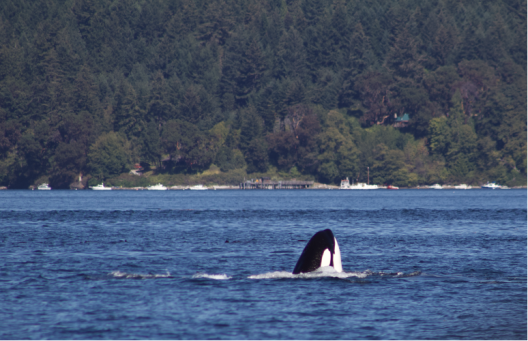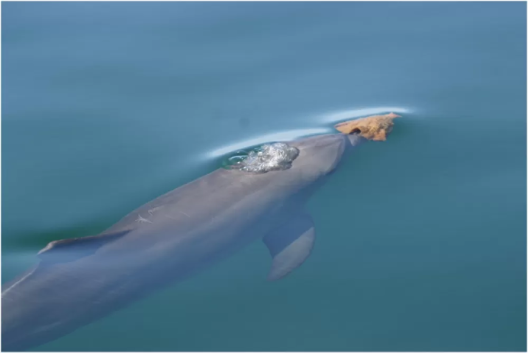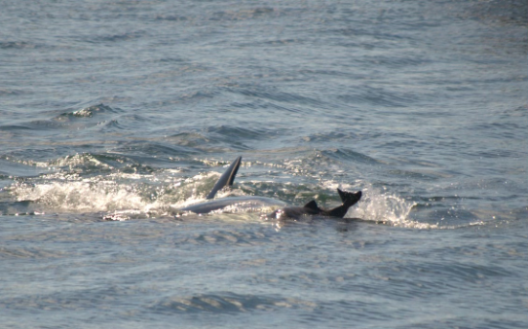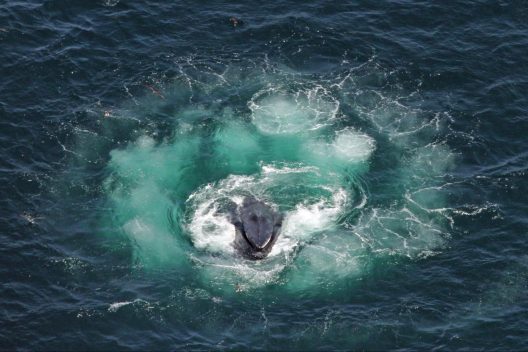Keeping up with the Cetaceans: The world’s real trendsetters

It’s been 16 years since we’ve been keeping up with the Kardashians and, let’s be honest, when it comes to modern terrestrial trendsetters, there is no one that holds a candle to them. Come to think of it, the frontiers of their athleisure dominion aren’t that far-flung. Of course, humans are the indisputable arbiters of trends, fashion, and what’s “in” on land. But the Kardashians can only strut their stuff and send their soulful selfies on the dry part of Earth.
What am I talking about when I connect cetaceans and fashion? Where do the denizens of the deep, the populace of the pelagic, the souls of the sublittoral go to find what is vestigially hip, what gizmos garner attention, or what thing-a-ma-bobs are trending? Well, if you’re in the know, you should be kicking the Kardashians to the curb and keeping up with the cetaceans instead.
Cetaceans, aka whales, are at the top of the marine world. They’re the biggest, the smartest, the fastest, and of course the most fashionable. A cetacean is any member of the order Cetacea.
Ce·ta·cea| siˈtāSH(ē)ə | plural noun Zoology
an order of marine mammals that comprises whales, dolphins, and porpoises. These have a streamlined hairless body, no hind limbs, a horizontal tail fin, and a blowhole on top of the head for breathing. See also Mysticeti, Odontoceti.
Humans love to categorize cetaceans by their mouthparts. You can divide them into two broad categories: toothed whales (Odontoceti) and baleen whales (Mysticeti). Since cetacean comes from the Latin word cetus, which just means whale, all cetaceans, whether they are dolphins, porpoises, or baleen whales, are considered whales! Toothed whales, as you might have guessed, have teeth. This category includes dolphins, porpoises, beaked whales, narwhals, belugas, and sperm whales. Baleen whales are the big boys: humpback whales, blue whales, gray whales, etc. These whales don’t have teeth, instead they have baleen. Baleen is made of rows of fibrous keratin plates that help filter their tiny food, like krill and small fish, out of gulps of water or sediment before they eat it.
But how are whales linked with fashion? When I talk about fashion and whales, I’m not talking about gray whales wearing Gucci or Dall’s porpoises sporting Dior. I’m talking more about fashion in a broader sense.
fash·ion| ˈfaSHən | noun
1 a popular trend, especially in styles of dress and ornament or manners of behavior.
Whales obviously don’t wear clothes designed by French fashion houses. Many whale species display behaviors that catch on and spread throughout the population. Whether the behaviors are a localized, colloquial phenomenon or a global, viral trend in the watery whale world, these behaviors start with an individual whale and spread through teaching and learning between other individuals. This can happen when one whale shows another, usually between unrelated individuals, or through behaviors passed down from one generation to the next. However the trends spread, they are fascinating and puzzling.
“Many whale species display behaviors that catch on and spread throughout the population. Whether the behaviors are a localized, colloquial phenomenon or a global, viral trend in the watery whale world, these behaviors start with an individual whale and spread through teaching and learning between other individuals.”
Let’s dive into high fashion. In the dolphin family, we see the use of objects for different reasons and these behaviors are usually passed vertically from mother to child or from another older family member to a younger member. Certain groups of bottlenose dolphins (Tursiops sp.) like to wear marine sponges to protect their faces as they go rummaging around the seafloor looking for food. This was first witnessed in one family of dolphins that was wearing the latest in Porifera headwear fashion. Researchers also witnessed that a mother would teach her daughters the same technique. Later, researchers found that the sponge-hat trend had spread to another family in the same bay and the matriarch of that family was passing along the behavior.

“In the dolphin family, we see the use of objects for different reasons and these behaviors are usually passed vertically from mother to child or from another older family member to a younger member. Certain groups of bottlenose dolphins (Tursiops sp.) like to wear marine sponges to protect their faces as they go rummaging around the seafloor looking for food.”
Another dolphin species, orcas (Orcinus orca), also organize their family groups matrilineally and pass information down to the next generation. These behaviors include their unique dialects, their preferred prey species, family hunting techniques, and hunting grounds. They also teach other behaviors like breaching, tail slapping, cartwheeling, and kelping!

Kelping is where whales play with kelp by wrapping it around their fins and swimming around with it. It is unknown why they do this other than it might feel good and, of course, it looks extremely cool. Other behaviors like this that don’t have very clear explanations, such as involving marine mammal-eating orcas playing with the intestines of the prey they just ate like it was kelp – pretty metal. Southern Resident orcas, who are another local type of orca that only eat fish species, have a fun trend where they play with and harass porpoises. They never eat them since they only eat fish species, but they chase, capture, and toss them around for a while until the porpoise unfortunately dies – very goth.

These are just a few brief examples of behaviors being transmitted among cetaceans. Passing on behaviors, creating trends that span families, populations, or even whole species are often used as evidence of culture in cetacean species. Other evidence comes in the fact that many of these species maintain postmenopausal females. This could indicate that these female elders act as knowledge carriers that retain successful behaviors and pass them on to future generations, thereby helping the species to survive and adapt to changes as well as pass along their favorite hat choices, whether they are kelp, porpoises, or intestines.
Most folks are familiar with the majestic humpback whale (Megaptera novaengliae). They are a global species and one of the many cetaceans that can be spotted off the coast of Washington state and even in the inland Salish Sea. Like most baleen whales, humpbacks are usually solitary creatures. They spend most of their lives traveling and feeding alone and, as far as we can tell, not forming lasting social bonds. We do see them occasionally gather, though. They travel great distances and form large groups during the breeding season where males compete to woo females. They will also gather in large groups on feeding grounds where they often cooperatively feed using various tactics that increase each of their chances of eating more.
In each of these spots there is a lot of communication through the dulcet humpback tones that may be familiar to you. You’ve most likely heard a recording of humpbacks; a recording of them was even sent to space!
Curious things happen at humpback gathering places. Cooperative feeding techniques are common. A tactic called bubble-net feeding can often be witnessed at these feeding aggregations. Bubble-net feeding is where groups of humpbacks dive deep and blow bubbles as they slowly surface. The “bubble net” pushes and concentrates the tiny prey up towards the surface, trapping them and allowing the team of humpbacks to easily feast and party together.

Humpback whales eat krill, other planktonic species, as well as schools of forage fish like herring or sand lance. Sometimes, though, there is no krill or the abundance of their main prey species changes. Changes in prey availability usually require changes in feeding techniques. As a new technique is developed by an individual whale, we soon see that new technique repeated by other individuals, not just in the local area but in other foraging areas too. And soon you can’t escape it no matter where you go, like a Mysticete Macarena. We saw this recently with a new lob-tail feeding technique where a whale slaps the water with its tail to help round up its forage fish prey.
The other gathering time for humpbacks is during breeding season. Breeding usually happens in warm, tropical waters during the winter months. A good place to witness this is in Hawai’i during the winter months. During breeding, the sea becomes alive with the humpback’s song. The songs are beautiful and complex, each breeding ground filled with a synchronous chorus of males singing in unison. But the song isn’t the same each year. The song changes and varies by breeding ground. Popular songs can sometimes get picked up and start to trend in totally different breeding grounds, replacing their old songs. Researchers have listened as a song is transmitted from one breeding ground to the next, year after year, sometimes traveling across the entire Pacific Ocean and moving through different ocean basins. The thought is that males pick up songs at one breeding ground and share it as they journey to other breeding grounds in later years. The tune eventually goes viral and all the humpbacks are doing it.
These behaviors might not be as flashy or elegant as a Paris runway or an L.A. scene, but they do let us see how our fashionable ocean neighbors transfer information between each other and down through generations. With humpbacks’ songs and sweet moves, we saw trends catch on between unrelated adults as individual whales taught and learned from each other because they apparently liked it or saw that it was working for the other whale. In orcas and bottlenose dolphins we saw seemingly playful behaviors of “wearing” different accessories be passed down from an older generation to the younger one. As researchers delve deeper into what constitutes each of these whale’s cultures and how their new trends develop and spread, it will be interesting to see how much more we can learn. These species have been present on the planet long before humans were humans and learning about how and why they use other objects or sounds to say different things could tell us more about us as humans and why we do the same. Let’s try to keep up with these cetaceans.
